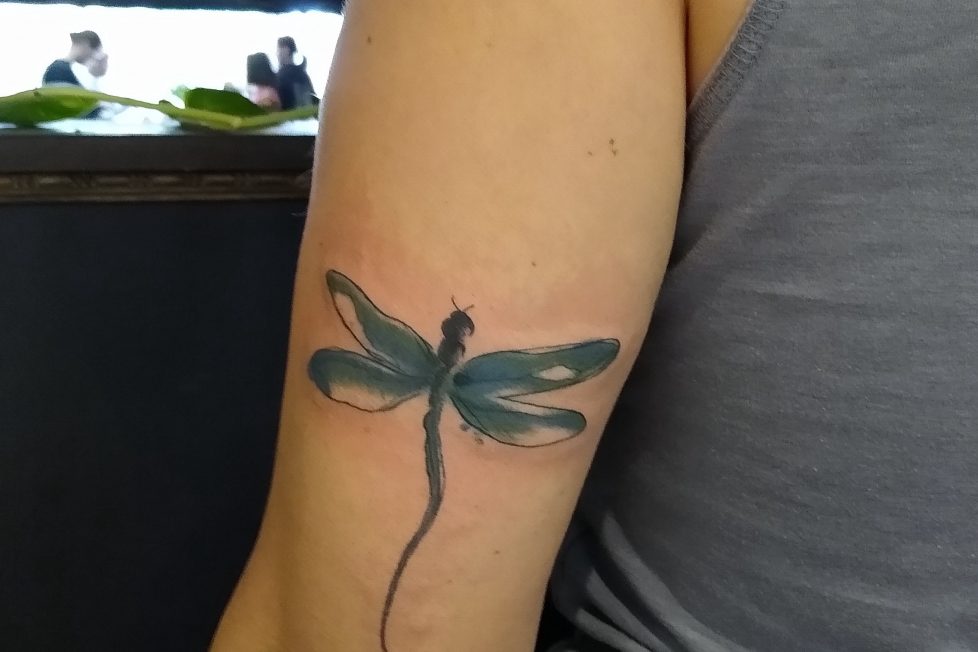The Woman With the Dragonfly Tattoo
"I can't imagine you without that tattoo," said my good friend.

"I can't imagine you without that tattoo," said my good friend.

Originally published on Medium in the Fearless She Wrote, February 2020.
“I can’t imagine you without that tattoo,” said my good friend after seeing my new dragonfly tattoo for the first time. It is my fourth tattoo. The dragonfly with blue-green wings flies up the back of my left upper arm. The insect represents change, transformation, adaptability, and self-realization. As humans, we undergo constant re-invention over the course of months, years, or decades. A tattoo stays with us through it all.
The evening after getting the new ink, I found myself out with a small group of friends. At the table, all five of us had tattoos. Three of us had multiple ones. I had gotten my first tattoo in my late twenties. One friend had gotten his first in his mid-thirties and now sporting two forearms and an upper arm with vibrant birds and sea life. Another friend at the table, who also happened to be a teacher, had a tattoo on her inner wrist that had been done by a former student. Adorning your body with ink has become commonplace.
Jobs that used to bulk at hiring people with visible tattoos are finding it harder and harder to find people without any. The stigma of tattoos has faded away. They are less a sign of rebellion and more a symbol of creativity. They are less a sign of rebellion and more a symbol of creativity.
I was told as a child to never get a tattoo. Buying into the idea that people with tattoos were somehow bad or dangerous, she had been raised to believe you never permanently alter your body, especially if you are a woman. The body was sacred. I would agree with that yes, the body is sacred. It might just be because of this sacredness that I and many others choose to adorn it with tattoos.
As my friends and I talked longer about tattoos, the conversation turned to whether or not your tattoo had to have meaning. Mine largely do. There is a cursive script on my inner thigh that is from a poetry piece I created. Cherry blossoms travel up my back next to initials representing that different places I’ve lived or had deep meaning to me. The dragonfly reminds me of a favorite character, a favorite author, and transformations happening in my life.
For others, an image they like is enough. Perhaps that is how it is for me. I like the way the dragonfly looks moving up my arm or the cherry blossoms growing on my back. The images are a part of me, the body a sacred canvas.
In Jun’ichirō Tanizaki’s short story, The Tattooer, a man who had dreams of becoming an accomplished ukiyo-e artist fails and resigns himself to becoming a tattooer. His craft becomes a spiritual communion between himself, the woman being tattooed, and the image as he strives to create. He is working towards a masterpiece. There are erotic undertones to the story. This is a man obsessed with the perfect woman for his perfect image. The result is terrifying when the woman and her tattoo become one. Whether chosen for some deeper meaning or because the image is compelling, the tattoo becomes a part of us.
In a world filled with mass consumer fashion and trends that changed every few months, the tattoo stays forever on the body, a distinct marker. No two tattoos can really be the same. The artist’s hand, the skin, the body all make a unique work of art.
Tattoos are an impermanent form of permanence. As much as they stay with us forever, they change over time, too, stretching or fading just as the body grows and changes. We can add to them or cover them up with new art. As we change so does the drawing on our body.
It is an intimate experience, both getting a tattoo and having one. Since many of mine aren’t visible in everyday clothing, the person or people that see them the most are those who share the most intimate moments with me. There is a distinct difference between seeing someone’s tattoos from across the pool while they are in a swimsuit and tracing the lines of a partner’s art with your fingers in bed. A shared experience with the artist, those who wear them, and those who see them, the lover who touches them. They communicate to others an unspoken language of what we are or what we wish to be through the most intimate medium, our skin.
